#pommersfelden
Explore tagged Tumblr posts
Text



Grotto Hall, Schloss Weissenstein, Pommersfelden, Germany,
Frank Burchert Photography
#art#design#architecture#history#luxury lifestyle#style#luxury house#luxury home#germany#grotto#hall#interiors#schloss#schloss weissenstein#pommersfelden#frank burchert
683 notes
·
View notes
Text

Pommersfelden - Bayern - Germany
#Pommersfelden#Bawaria#Bayern#litho#litografia#pocztówka#post card#kartka#niemcy#germany#Bavaria#zamek#Schloss#castle
0 notes
Text

Georg Pencz (German, 1500-1550) Melancholie, 1545 Germany: Schloss Weißenstein, Pommersfelden, Bavaria (paint on oak, 480 x 580 mm)
sources: Wikimedia Common, https://commons.wikimedia.org/wiki/File:Georg_Pencz_-_Die_Melancholie.jpg Bildindex der Kunst & Architektur, https://www.bildindex.de/document/obj00010442
5 notes
·
View notes
Text







Artemisia Lomi or Artemisia Gentileschi (US: /ˌdʒɛntiˈlɛski/,[1][2] Italian: [arteˈmiːzja dʒentiˈleski]; 8 July 1593 – c. 1656) was an Italian Baroque painter. Gentileschi is considered among the most accomplished seventeenth-century artists, initially working in the style of Caravaggio. She was producing professional work by the age of 15.[3] In an era when women had few opportunities to pursue artistic training or work as professional artists, Gentileschi was the first woman to become a member of the Accademia di Arte del Disegno in Florence and she had an international clientele.
Many of Gentileschi's paintings feature women from myths, allegories, and the Bible, including victims, suicides, and warriors. Some of her best known subjects are Susanna and the Elders (particularly the 1610 version in Pommersfelden), Judith Slaying Holofernes (her 1614–1620 version is in the Uffizi gallery), and Judith and Her Maidservant (her version of 1625 is in the Detroit Institute of Arts).
Gentileschi was known for being able to depict the female figure with great naturalism and for her skill in handling colour to express dimension and drama.
#happy birthday to my historical crush#artemisia gentileschi#art#baroque#italian art#italian painter#female artists#classical art#fine art#cw: blood#WOMEN 😍
23 notes
·
View notes
Text

📍𝐒𝐜𝐡𝐥𝐨𝐬𝐬 𝐖𝐞𝐢𝐬𝐬𝐞𝐧𝐬𝐭𝐞𝐢𝐧 𝐢𝐧 𝐏𝐨𝐦𝐦𝐞𝐫𝐬𝐟𝐞𝐥𝐝𝐞𝐧
Step into the breathtaking Grotto Hall of Schloss Weissenstein in Pommersfelden, where Franconian elegance meets natural beauty. With its intricate shellwork, shimmering mosaics, and baroque splendor, this hidden gem feels like a journey into an enchanted world. ✨🏰
#SchlossWeissenstein #BaroqueBeauty #HiddenGems
𝐒𝐨𝐮𝐫𝐜𝐞: @𝐩𝐚𝐥𝐚𝐜𝐞.𝐫𝐞𝐟𝐥𝐞𝐜𝐭𝐢𝐨𝐧𝐬(𝐅𝐫𝐚𝐧𝐤 𝐁𝐮𝐫𝐜𝐡𝐞𝐫𝐭). 𝐓𝐡𝐚𝐧𝐤 𝐲𝐨𝐮 𝐤𝐢𝐧𝐝.
0 notes
Text

Artist Artemisia Gentileschi
Judith and Maidservant with Head of Holofernes (between circa 1623 & 1625)
oil on canvas
184 cm x 141.6 cm (72.4 in x 55.7 in)
https://palianshow.wordpress.com/2022/04/18/artemisia-gentileschi-italy-1593-1656/
In an era when women had few opportunities to pursue artistic training or work as professional artists, Gentileschi was the first woman to become a member of the Accademia di Arte del Disegno in Florence and she had an international clientele.
Many of Gentileschi's paintings feature women from myths, allegories, and the Bible, including victims, suicides, and warriors.
Some of her best known subjects are Susanna and the Elders (particularly the 1610 version in Pommersfelden), Judith Slaying Holofernes (her 1614–1620 version is in the Uffizi gallery), and Judith and Her Maidservant (her version of 1625 is in the Detroit Institute of Arts).
Artemisia Lomi or Artemisia Gentileschi (US: /ˌdʒɛntiˈlɛski/, Italian: [arteˈmiːzja dʒentiˈleski]; 8 July 1593 – c. 1656) was an Italian Baroque painter. Gentileschi is considered among the most accomplished seventeenth-century artists, initially working in the style of Caravaggio. She was producing professional work by the age of fifteen.
about the artwork: Judith and her servant pause, seeming to hear a noise outside Holofernes’ tent. The shadowy interior is theatrically illuminated by a single candle. Judith’s hand shields her face from the glow, drawing attention to Holofernes’ discarded iron gauntlet. The viewer’s eye travels to the object in the maidservant’s hands: Holofernes’ severed head.
source: Wikipedia
#ArtemisiaLomi #ArtemisiaGentileschi #artherstory #womensart #greatfemaleartists #PalianShow
1 note
·
View note
Photo

If, like me, you have binge watched The Empress on Netflix, then you’ll be sure to recognise the sumptuous Baroque interior of the Weissenstein Palace, Bavaria. The Palace is depicted as the main royal residence of the most-striking Empress Elizabeth of Austria and Queen of Hungary, also known as Empress Sisi, whose legendary life still fascinates fully 120 years after her tragic death. Slide two is my favourite portrait of Empress Sisi, by Franz Xaver Winterhalter, 1865. Photograph via AD #schlossweesenstein #wessenstein #palace #pommersfelden #bavaria #theempress #netflix #empresssissi #entrance #entrancehall #interiordesign #interiordesigner #decor #frescoes #art #baroque #baroquepalace #baroquestyle #interior #interiors #interiordecor #interiordecorating #interiordecoration #interiordecorator #franzxaverwinterhalter #artwork #artist #18thcenturypalace #interiorarchitecture #classicalinteriors (at Bavaria, Germany) https://www.instagram.com/p/ClWNH78oQku/?igshid=NGJjMDIxMWI=
#schlossweesenstein#wessenstein#palace#pommersfelden#bavaria#theempress#netflix#empresssissi#entrance#entrancehall#interiordesign#interiordesigner#decor#frescoes#art#baroque#baroquepalace#baroquestyle#interior#interiors#interiordecor#interiordecorating#interiordecoration#interiordecorator#franzxaverwinterhalter#artwork#artist#18thcenturypalace#interiorarchitecture#classicalinteriors
8 notes
·
View notes
Photo

#schlossweissenstein #pommersfelden (hier: Schloss Weißenstein) https://www.instagram.com/p/B0P3ynDoqRA/?igshid=4hd5mum0okc
1 note
·
View note
Photo
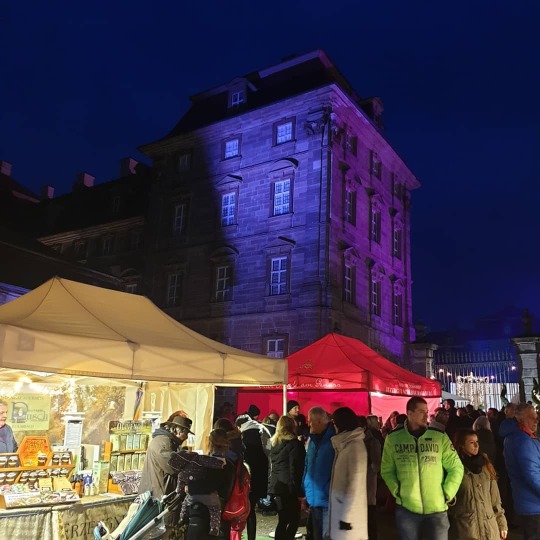
Nachdem wir heute erstmal einen Abstecher zum #MartiniMarkt in #SulzbachRosenberg gemacht hatten, ging es anschließend noch nach #Schloss #Weißenstein in #Pommersfelden. Hier war heute der letzte Tag der #Winterlust. Waren überrascht das so viele Leute da waren, aber auf dem großen Gelände war das kein Problem... War ein schöner Tag mit der Familie!! 👌 (hier: Schloss Weißenstein) https://www.instagram.com/p/B4-dAbXnFIY/?igshid=1a2017pvucrkw
0 notes
Photo

Schloß Weissenstein in Pommersfelden @gartenlust2018 wie immer ein Fest! Die dunklen Wolken sind verzogen und jetzt rockt der Bär! Proud to be at the @gartenlust2018 in Pommersfelden! #ana_sosnowicz_kids #Pommersfelden #zebrastelzentheater #kids #handmade #child #garden #madewithlove #toddler #life #lifestyle #likeforlikes #likeforfollow https://www.instagram.com/p/BxVJoM_g5Yl/?utm_source=ig_tumblr_share&igshid=1pkpvygnuquz5
#ana_sosnowicz_kids#pommersfelden#zebrastelzentheater#kids#handmade#child#garden#madewithlove#toddler#life#lifestyle#likeforlikes#likeforfollow
0 notes
Text

Schloss Weißenstein, Pommersfelden, Bavaria, Germany,
Courtesy: Palace Reflection
#art#design#architecture#history#luxury lifestyle#style#luxury house#luxuey home#schloss#schloss weissenstein#palatial#bavaria#germany#pommersfelden#hall#marble hall
551 notes
·
View notes
Text








Netflix Germany shared the filming location of the first season of The Empress (2022) on their instagram page. Most of them are in the state of Bavaria in Southern Germany.
For the outside of Schönbrunn Castle in Vienna Weissenstein Castle in Pommersfelden was used, where they also shot the dancing lesson, while the palace chapel is actually the church Münster St. Georg in Dinkelsbühl. The garden scenes where shot at Eremitage Castle in Bayreuth.
Fantaisie Castle in Eckersdorf and Paradiestal near Stadelhofen stood in for Auhof Castle and its forest.
Most indoor scenes were shot at Studio Babelsberg in Potsdam near Berlin, Europe's biggest film studio that has been and is still used by many Hollywood and international productions.
67 notes
·
View notes
Photo

Antonio Bellucci, 1654-1726
Rebecca at the Well, ca.1700, oil on canvas, 176×135 cm
Schloss Weissenstein, Pommersfelden
22 notes
·
View notes
Text
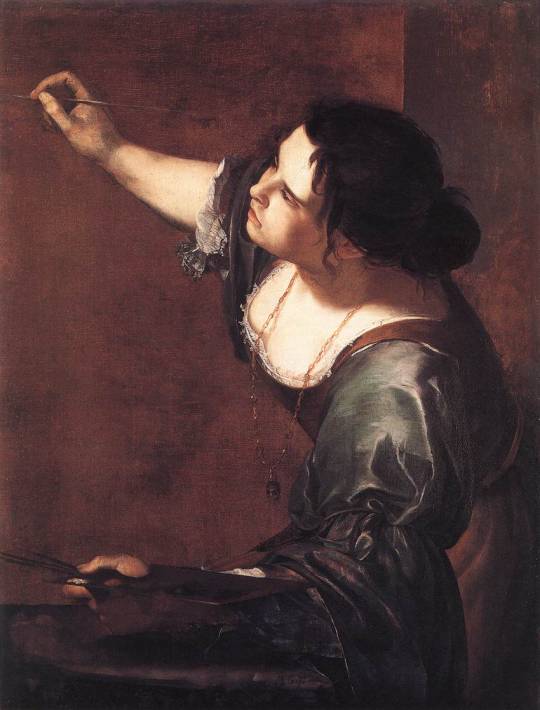
By: Amy Fredrickson
Artemisia Gentileschi was born on July 8, 1593, in Rome and is one of the most distinguished artists of her generation. She challenged the societal limitations placed on female artists during her time and became a successful history painter in her own right. Her career took her from Rome to Florence, Venice, London, and Naples, where she worked for elite patrons such as the Medici family in Florence and King Philip IV of Spain.
Artemisia was the eldest of Prudenzia Montoni and Orazio Lomi Gentileschi’s (1563–1639) five children as well as their only daughter. She was born into an artistic family. In addition to her father, her grandfather Baccio Lomi (c.1550–1595) and her uncle Aurelio Lomi (1556 – 1622) were well-known Pisan painters.

Originally a mannerist-style painter, Orazio became a follower of Caravaggio’s practice of working from nature, and he trained Artemisia to paint in this manner. As a child, Artemisia worked in his studio, mixing pigments and making varnishes. She learned the techniques of chiaroscuro, which was characteristic of Caravaggist paintings. In turn, Artemisia was a second-generation champion of Caravaggio’s realism; her first recorded paintings are almost indistinguishable from her father’s, such as Susanna and the Elders (1610). Painted a few years later, Judith and Her Maidservant (c.1614-20) in the Palazzo Pitti sets her apart from Orazio for its emotive protagonists and deep tenebrism.
Orazio hired painter Agostino Tassi (1578 – 1644) to tutor Artemisia. In the spring of 1611, Tassi raped her, and he refused to fulfill his promise to marry her. Orazio took him to trial because the crime against his daughter was a crime against his family’s honor. Artemisia’s infamous 1612 trial was well-documented and lasted seven months. She was forced to provide a testimony under torture. Found guilty, Tassi was sentenced to banishment from Rome for five months; however, his punishment was not enforced.
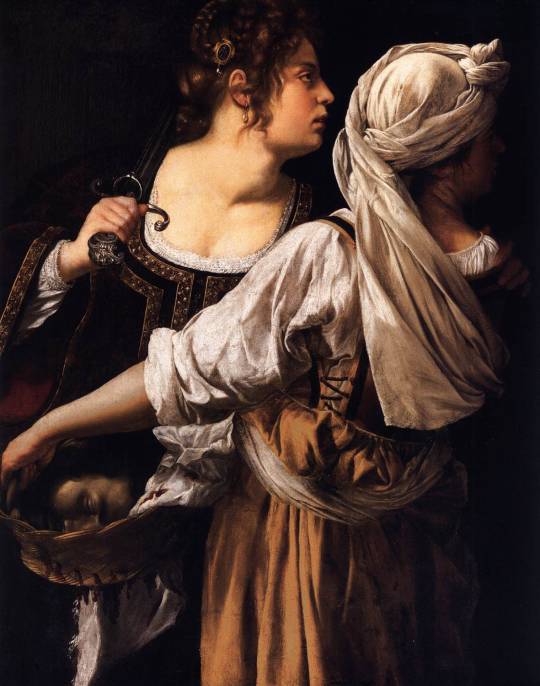
Shortly after, Artemisia married Florentine artist Pietro Antonio di Vincenzo Stiattes (b.1584), and they moved to Florence. Before their arrival, Orazio wrote to the dowager Grand Duchess of Tuscany, Christina of Lorraine, requesting her help in preventing Agostino Tassi's release from the Corte Savella where he was being jailed. In return, Orazio offered to send her one of Artemisia's paintings, Judith and Her Maidservant (c.1614-20).
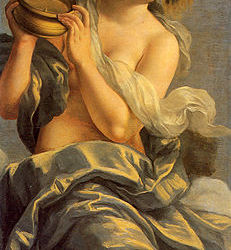
Artemisia established herself as an independent artist in Florence, and she began developing her distinct style. She pushed against the societal norms established for women during her time, such as relegating women painters to the genre of still life or portraiture. Instead, she concentrated on history painting. She established herself within Florentine literary circles, which led to commissions from the Medici family and Michelangelo Buonarotti the Younger. She painted Judith and Holofernes (c. 1612–1621) and the Penitent Mary Magdalene (1620–1625) in the Palazzo Pitti for the Medicis, and for Casa Buonarotti, she painted a ceiling painting called the Allegory of Inclination (1615–1617). Her Florentine paintings illustrate her development beyond her father’s teachings and those of Caravaggio as she introduced a more polished surface, brighter colors, and sophisticated iconography. Perhaps these advances were a product of her association with the poets, painters, and intellectuals she had encountered in Florence. In 1616, Artemisia became the first female member of the Accademia delle Arti del Disegno.

Artemisia was business savvy; she ran her own studio and controlled her finances. The move to Rome may have coincided with Grand Duke Cosimo II de’ Medici’s death in 1621. His successor was Ferdinando, his ten-year-old son, who was governed by his mother and grandmother, and ultimately, their tastes leaned toward penitent biblical figures rather than Artemisia’s bloodletting heroines.
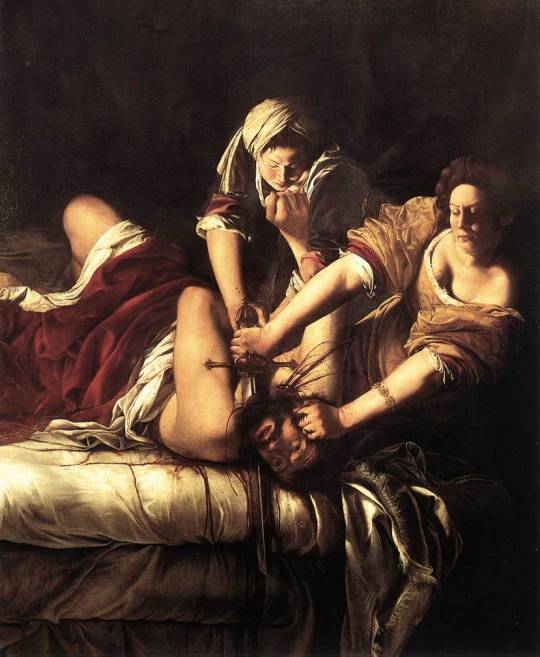
In 1620, Artemisia and her husband returned to Rome for approximately six years. Judith and her Maidservant (c. 1623-25), now in Detroit, dates to this time, although how many paintings Artemisia produced during her second Roman period is unclear. Little is known about her involvement in Roman artistic circles of this period, yet Simon Vouet’s portrait of Artemisia for the papal secretary Cassiano dal Pozzo provides some insight that she was associated with an elite circle of patrons and possibly the Academy of the Desiosi.
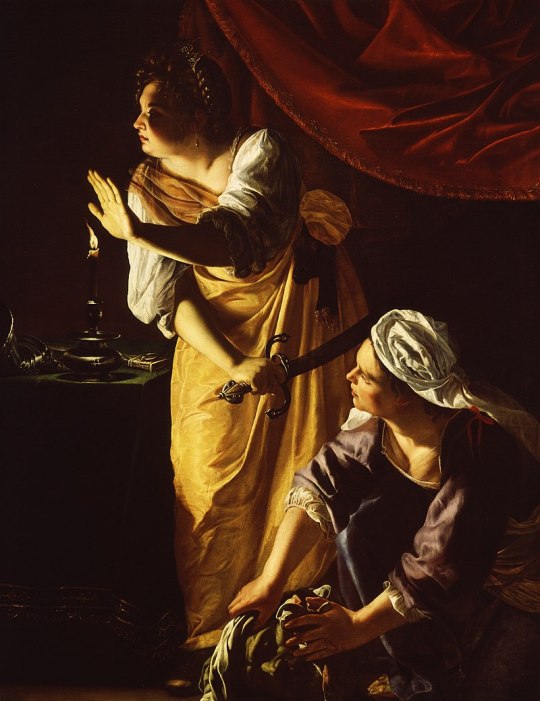
In 1627, Artemisia traveled to Venice for a few years to possibly attain commissions. During her Venetian sojourn, she participated in literary circles such as the Accademia degli Incogniti. Venetian poetry of this time alludes to her status in these circles. While in Venice, Artemisia began to specialize in monumental biblical and historic women; the subject of these paintings featured the triumphs and tragedies of these heroines.

In 1629, the Spanish viceroy, the Duke of Alcalá, invited Artemisia to Naples, and a year later, she resided in Naples and ran a successful studio. A remarkable example of this period is her Esther before Ahasuerus (1627-1630), which hints at her Venetian sojourn. The incorporated grandiose movements and ornamental dress emit an operatic air.
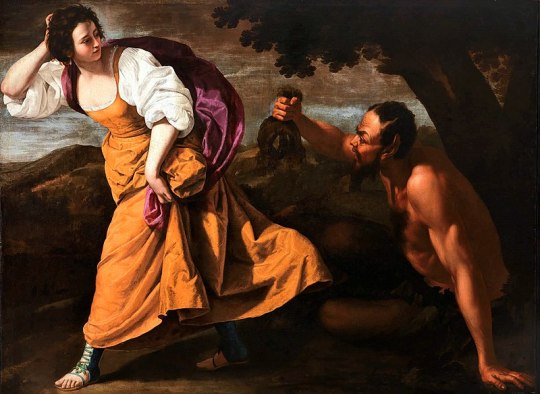
Her recently discovered paintings, such as Corsica and the Satyr (c. 1630-35) and Christ and the Samaritan Women (c. 1637), reveal that the 1630s marked a high point in her career. What sets these works apart from her earlier paintings are her lyrical subjects and the loose Venetian-inspired brushwork of broad white strokes with colors applied on top. During the 1630s, she began incorporating rich colors, such as ochres, blues, and cinnabar red. Artemisia created dimension and drama through her use of such rich hues.

Artemisia left Naples in 1638 to assist her ill father in London. Orazio worked for the English court beginning in 1626 and was working on ceiling paintings for the Great Hall in the Queen’s House in Greenwich. By 1640, she returned to Naples, where she remained until her death. It is unknown when she died, but a recently discovered document shows her living in Naples in August 1654. It is plausible that Artemisia died during the 1656 plague that had ravaged Naples and killed half of its inhabitants.
Images:
Self-Portrait as the Allegory of Painting, c.1630, oil on canvas, 96,5 x 73,7 cm., Royal Collection, Windsor
Susanna and the Elders, 1610, oil on canvas, 170 x 121 cm., Schloss Weissenstein, Pommersfelden
Judith and Her Maidservant, c.1614-20, oil on canvas, 114 x 93.5 cm., Galleria Palatina (Palazzo Pitti), Florence
Allegory of Inclination, c. 1615, oil on canvas (ceiling), 152 cm × 61 cm., Casa Buonarroti, Florence
The Penitent Mary Magdalen, 1620-25, oil on canvas, 146 x 109 cm., Galleria Palatina (Palazzo Pitti), Florence
Judith Beheading Holofernes, 1612-21, oil on canvas, 199 x 162 cm., Galleria degli Uffizi, Florence
Judith and her Maidservant, c. 1623–1625, oil on canvas, 184 x 141.6 cm., Detroit Institute of Art.
Esther Before Ahasuerus, c. 1627-1630, oil on canvas, 208.3 cm x 273.7 cm., Metropolitan Museum of Art.
Corsica and the Satyr, c.1630-35, oil on canvas, 155 x 210 cm., Private Collection.
Christ and the Samaritan Women, c. 1637, oil on canvas, 267.5 x 206 cm., Private Collection.
References:
Sheila Barker, 'Artemisia's Money: The Entrepreneurship of a Women Artist in Seventeenth-Century Florence,' Artemisia Gentileschi in a Changing Light, ed. by Sheila Barker (London, 2018), pp 59-88
Breeze Barrington, 25 April 2020, "The Trials And Triumphs Of Artemisia Gentileschi," Apollo Magazine. [online] <https://www.apollo magazine.com/artemisia-gentileschi-london/>
Ward R. Bissell, Artemisia and the Authority of Art: Critical Reading and Catalogue Raisonné (University Park, 1999)
Ward R. Bissell,‘Artemisia Gentileschi-A New Documented Chronology,’ The Art Bulletin 50, no. 2, (1968), pp. 153–168.
Patrizia Costa, ‘Artemisia Gentileschi in Venice’, Source: Notes in the History of Art 19, no. 3, (2000), pp. 28-36
Mary D. Garrard, 'Artemisia Gentileschi's 'Corisca and the Satyr,'' The Burlington Magazine 135, no. 1078 (1993), pp. 34-38
Mary D. Garrard, Artemisia Gentileschi: The Image of the Female Hero in Italian Baroque Art (Princeton, 1989)
Jesse Locker, Artemisia Gentileschi: The Language of Painting (New Haven, 2015)
#artemisia#artemisia gentileschi#florence#rome#caravaggisti#Caravaggio#Baroque Art#women artists#female artist#heroines#judith#judith and holofernes#susanna and the elders#self portrait
49 notes
·
View notes
Text

Schloss Weissenstein, Pommersfelden. Si tratta di un'imponente costruzione barocca che sorge nella lussureggiante ed amena campagna bavarese; nel comune di Pommersfelden, nei dintorni di Bamberga, una delle più belle città d'arte della regione.
1 note
·
View note
Text
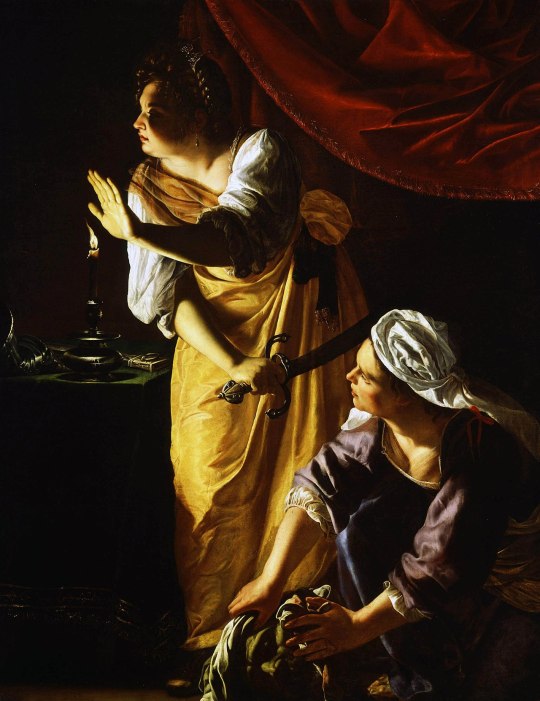
Artist Artemisia Gentileschi
Judith and Maidservant with Head of Holofernes (between circa 1623 & 1625)
oil on canvas
184 cm x 141.6 cm (72.4 in x 55.7 in)
https://palianshow.wordpress.com/2022/04/18/artemisia-gentileschi-italy-1593-1656/
In an era when women had few opportunities to pursue artistic training or work as professional artists, Gentileschi was the first woman to become a member of the Accademia di Arte del Disegno in Florence and she had an international clientele.
Many of Gentileschi's paintings feature women from myths, allegories, and the Bible, including victims, suicides, and warriors.
Some of her best known subjects are Susanna and the Elders (particularly the 1610 version in Pommersfelden), Judith Slaying Holofernes (her 1614–1620 version is in the Uffizi gallery), and Judith and Her Maidservant (her version of 1625 is in the Detroit Institute of Arts).
Artemisia Lomi or Artemisia Gentileschi (US: /ˌdʒɛntiˈlɛski/, Italian: [arteˈmiːzja dʒentiˈleski]; 8 July 1593 – c. 1656) was an Italian Baroque painter. Gentileschi is considered among the most accomplished seventeenth-century artists, initially working in the style of Caravaggio. She was producing professional work by the age of fifteen.
about the artwork: Judith and her servant pause, seeming to hear a noise outside Holofernes’ tent. The shadowy interior is theatrically illuminated by a single candle. Judith’s hand shields her face from the glow, drawing attention to Holofernes’ discarded iron gauntlet. The viewer’s eye travels to the object in the maidservant’s hands: Holofernes’ severed head.
source: Wikipedia
3 notes
·
View notes